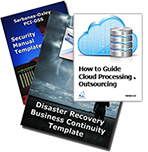Cloud Computing Requirements and Best Practices
Best practices are defined by top CIOs
 CIOs require that cloud-computing providers meet the highest standards of service. After all, they are entrusting them with critical corporate process and data. Cloud computing requirements are the building blocks for the best practices that every CIO is striving to meet. Included in the requirements are:
CIOs require that cloud-computing providers meet the highest standards of service. After all, they are entrusting them with critical corporate process and data. Cloud computing requirements are the building blocks for the best practices that every CIO is striving to meet. Included in the requirements are:
- World-class security - Provision world-class security at every level. Security is more than just user privileges and password policies. It's a business imperative, especially for providers who are responsible for customer data. Cloud-computing platforms must have detailed, robust policies and procedures in place to guarantee the highest possible levels of:
- Physical security
- Network security
- Application security
- Internal systems security
- Secure data-backup strategy
- Secure internal policies and procedures
- Third-party certification
- Compliance, trust and transparency - Provide compliant, transparent, real-time, accurate service performance and availability information. Clouds should provide customers with detailed information about service delivery and performance in real time, including:
- Accurate, timely, and detailed information about service performance data and planned maintenance activities
- Daily data on service availability and transaction performance
- Proactive communication
- Multi tenancy - Deliver maximum scalability and performance to customers with a true
multi tenant architecture. A multi tenant architecture allows for high scalability and faster
innovation at a lower cost. Single-tenant systems, on the other hand, are not designed for large-scale cloud-computing success. The internal inefficiencies of maintaining a separate physical infrastructure and/or separate code lines for each customer make it impossible to deliver quality service or innovate quickly. Multi tenancy provides customers with the following benefits:- Efficient service delivery, with a low maintenance and upgrade burden
- Consistent performance and reliability based on an efficient, large-scale architecture
- Rapid product release cycles
- Scalability - Support many users with proven scalability. A larger scale means a larger customer community, which can deliver more and higher-quality feedback to drive future innovation. A larger customer community also provides rich opportunities for collaboration between customers, creating communities that can share interests and foster best practices. Cloud-computing platforms must have:
- Proof of the ability to scale to many subscribers
- Resources to guarantee the highest standards of service quality, performance, and security to every customer
- The ability to grow systems and infrastructure to meet changing demands
- Support that responds quickly and accurately to every customer
- Proven performance and reliability as customer numbers grow
- High performance - Deliver consistent, high-speed performance globally. Cloud-computing provider's platforms must deliver consistent, high-speed systems performance worldwide and provide detailed historical statistics to back up performance claims, including:
- Average page response times
- Average number of transactions per day
- Functional disaster recovery and business continuity options - Protect customer data by running the service on multiple, geographically dispersed data centers with extensive backup, data archive, and fail over capabilities. Platforms providing cloud-computing services must be flexible enough to account for every potential disaster. A complete disaster recovery plan includes:
- Data backup procedures that create multiple backup copies of customers' data, in near real time, at the disk level
- A multilevel backup strategy that includes disk-to-disk-to-tape data backup in which tape backups serve as a secondary level of backup, not as the primary disaster-recovery data source. The disk-oriented model ensures maximum recovery speed with a minimum potential for data loss in the event of a disaster.
- High availability - Equip world-class facilities with proven high-availability infrastructure and
application software. Any provider offering cloud-computing services needs to be able to deliver very high availability. Requirements for proving high availability include:- Facilities with reliable power, cooling, and network infrastructure
- High-availability infrastructure: networking, server infrastructure, and software
- N+1 redundancy
- Metrics with detailed historical availability data on the entire service, not just on individual servers
The need to lower cost, increase efficiency and conserve cash has increased the motivation of companies to turn to Cloud Computing and increased the appeal of alternative delivery models. The disruptive shifts in new demand and supply patterns drives changes for how IT services are bought and from whom.
The Practical Guided for Cloud Outsourcing Template includes -- Sample Cloud Outsourcing Contract along with a Service Level Agreement and other tools to facilitate the cloud outsourcing process. The template includes Janco's exclusive Business and IT Impact Questionnaire.
Order Cloud Outsourcing Download Selected Pages




